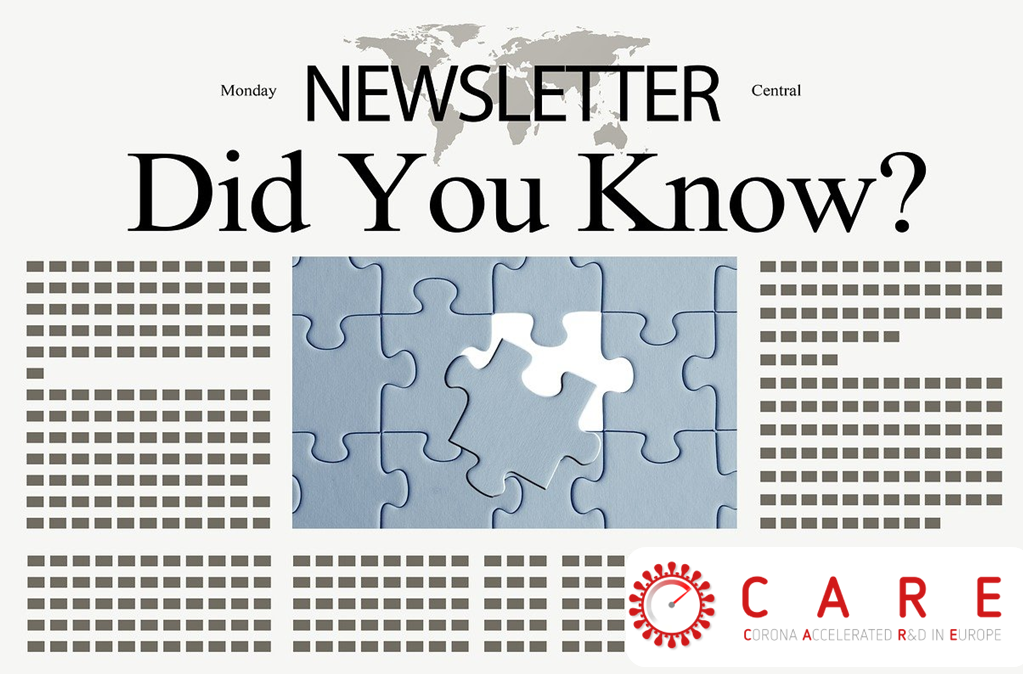One Year of CARE Against COVID-19 / Interview Part 3 /
On March 11, 2020 the novel coronavirus outbreak has been declared a pandemic. To combat the virus, multiple approaches are needed including therapeutic options that help those who are infected and those who are not able to be vaccinated or do not develop a strong immune response. In addition, there is a need for therapeutic approaches that help preparing for future outbreaks. Less than a month later, on April 1, 2020 the CARE consortium was formed to collaborate under as a public-private partnership to address these challenges as Europe’s largest research initiative in the fight against SARS-CoV-2 funded by the Innovative Medicines Initiative (IMI).
In this three-part interview series, the members of the CARE Executive Committee reflect on the first of five years of CARE, answering questions like:
- How was the team able to set up a consortium of 37 partners in a record time?
- How can a project of this size make notable progress albeit not working together face-to-face?
- How can CARE help to develop relevant therapeutic options?
Professor Yves Lévy as the academic coordinator, Marnix Van Loock as the EFPIA project leader and Kumar Singh Saikatendu as the project co-leader provided answers and insights below.
Part 3 – FINDING SOLUTIONS: A two-pronged strategy to develop relevant assets
CARE is a five-year project with the aspiration to discover and develop several new and effective medicines and follows a two-fold strategy: a shorter-term emergency response track through drug repurposing as well as on a longer-term track for the discovery of new therapeutic candidates to prepare for the current and future outbreaks.
What does it mean for you to be in a project progressing these two tracks simultaneously and where do they stand?
Marnix van Loock: Right from the start of the CARE consortium, our ambitions have been clear: to identify opportunities that support the imminent relief for COVID-19 patients during the current pandemic which has recently been complicated with the identification of the variants of concern; and to prepare for the future. Within CARE, we screened the compound libraries of our partners with the aim to find candidates for repurposing. Unfortunately, these efforts did not yield any clinical candidates. However, the antibody development is already showing promising results with highly potent SARS-CoV-2 neutralizing antibodies.
Yves Lévy: It’s important to highlight that we treat both tracks with the same commitment as there are strong links between the emergency response and the long-term strategy. The findings in the fight against the current pandemic benefit the track for the future pandemic preparedness.
The CARE project is navigating a changing landscape and accordingly the strategy includes finding solutions for coronavirus variants. How do the new coronavirus variants impact the work and strategic orientation of CARE?
Yves Lévy: The CARE consortium follows a very reactive approach and includes the variants of concern in its research, for example by testing the SARS-CoV-2 neutralizing antibodies against these variants.
Marnix van Loock: The evolving SARS-CoV-2 landscape is indeed very high on the agenda of the CARE partners. We proactively incorporate this aspect into the project’s strategy to guarantee that the assets in development stay relevant. For this, we brought all leaders of the work packages together to discuss and outline the impact of the variants of concern and defined strategies accordingly. Actually, the emergence of the coronavirus variants increases the importance of CARE’s work!
The CARE Executive Committee wishes to express its gratitude towards each member of the CARE consortium appreciating their enthusiasm, scientific passion, drive and willingness to collaborate that build the heart of CARE – a heart that is beating vividly due to everyone’s time and effort.
– Sarah Soetbeer
This is the last part of the three-part interview with the CARE Executive Committee. Please find the other parts here.




